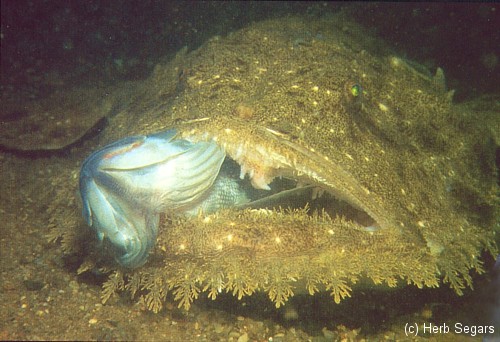I retell this story regularly, and get a variety of responses. As such, I thought I’d add it to the blog. I really don’t recall the date, so let’s just say “long, long, ago in an ocean just off the beach”, I spotted my first Monkfish. I don’t have my own picture of one, so I’ll have to reference a shot by Herb Segars. 
A little background for those of you unfamiliar with these creatures. They are often called goose fish, or all mouth. The latter is more a description, and an accurate one. They are in the anglerfish family, and are mostly head and mouth. They grow to over 5 ft in length, but 3 ft is more common. They lie flat on the bottom with their belly down (like a skate or ray) but with the mouth facing up. They are also well camouflaged. When food (fish, lobster, crab, diver … ) comes within range, they quickly open their huge mouth which sucks water into their mouth and hopefully the prey comes with it. If they don’t completely swallow their prey on the first attempt, the rows of sharp teeth hold it in place for a second or third try. Basically they are a large ugly eating machine. The part of the fish that is not mouth, is mostly stomach. On the other hand, the little bit of fish that remains is very good eating.
Stories are told of divers not seeing the fish, and kneeling on them, or putting their hands on them. The shock factor having the sand come alive and try to grab you with rows of teeth, is the subject of many a dive tale. Others tell of battles with the beast which often resulted in leaking drysuit or torn gloves.
Back to the story. So here I am, novice diver swimming along spearfishing sea bass and totaug. While making a pass over an old derelict lobster pot, I notice an odd shape in the sand. It’s clearly not a fluke, and after a few seconds, I come to the conclusion that it’s a Monkfish. Now what? I’m not sure I want to argue with it, as it was larger than any fish I’ve encountered to date. As I was the last in the water, and my dive is about done, I know Captain George should be down here somewhere hunting lobsters and getting ready to pull the hook. I quickly found him and signal him over.
The ensuing conversation was all made with hand signals and gestures, but went something like this:
George: Do you want him?
Dave: I guess.
George: Open your bag in front of him, and I’ll prod him into it.
Dave: OK, but I hope I don’t lose the fish in the bag.
Monkfish: I’m not that dumb. Stop putting that bag in my face.
One plan down. Now what? George bouncy castle for sale motioned for me to hand him my bag. I obliged. George opened the bag, then with one motion, he picked up the fish by the tail, and dropped it into the bag and closed it, before the fish had a chance to react. He handed me the bag, waved goodbye, and went back to hunting lobster.
I could not help but laugh after hearing stories about these beasts. My dive time was done, so I headed up the line. Picture if you will, I’m holding the anchor line in one hand, and a bag of fish, including a very aggravated Monkfish in the other. He’s got his mouth wide open, and I’m looking at rows of teeth that would easily poke holes in my drysuit. My bag was one with a metal loop around the top that acts like an old style woman’s purse. I finally figure out that sticking one end of the metal loop in his mouth will cause him to bite down, therefore preventing him from attacking me.
With a small degree of satisfaction, I board the boat only to find that I had avoided one attack, but fell victim of another. Another endearing property of Monkfish, they generate slime. Lots of it. I guess It’s either part of their camouflage, or stomach secretions from having it’s mouth open during the ascent. Either way, I’ve been slimed! My drysuit looked as if a giant had sneezed on me. I put my catch bag in my cooler, then jumped back in water to clean the suit.
After everyone was aboard, we discovered that no one knew how to clean a Monkfish. Fortunately, when we returned to the dock, George was able to find a commercial fisherman with the required knowledge, and hankering for lobster. He made quick work of the task, and several of us went home with fillets in hand. I mean cooler.
In the end, Monkfish is good eating, but I must warn you, they are not for the timid. It was a few years before I went for another one. They are not to be trifled with. They’re a mess to bring up, and a smelly mess to fillet.
